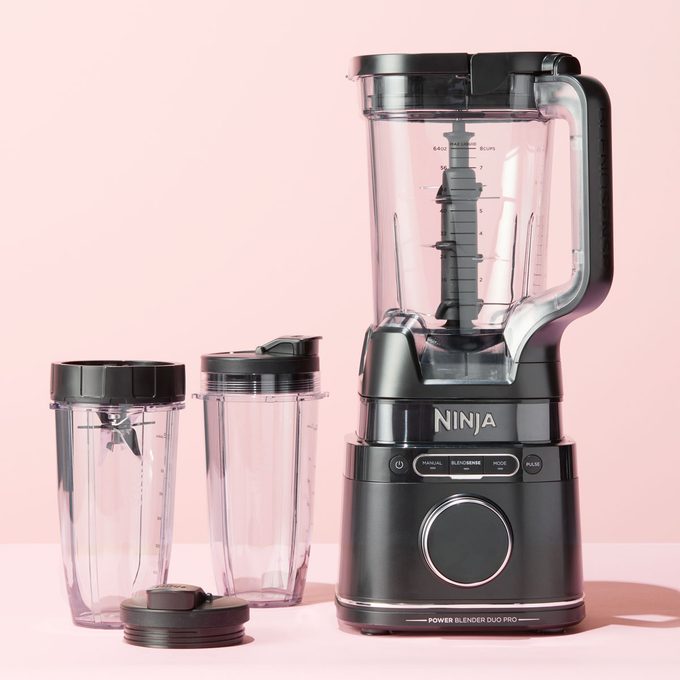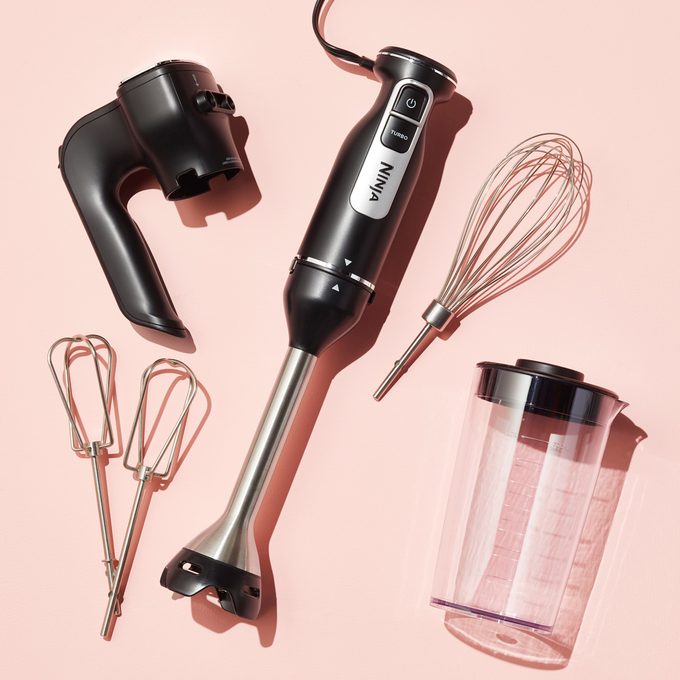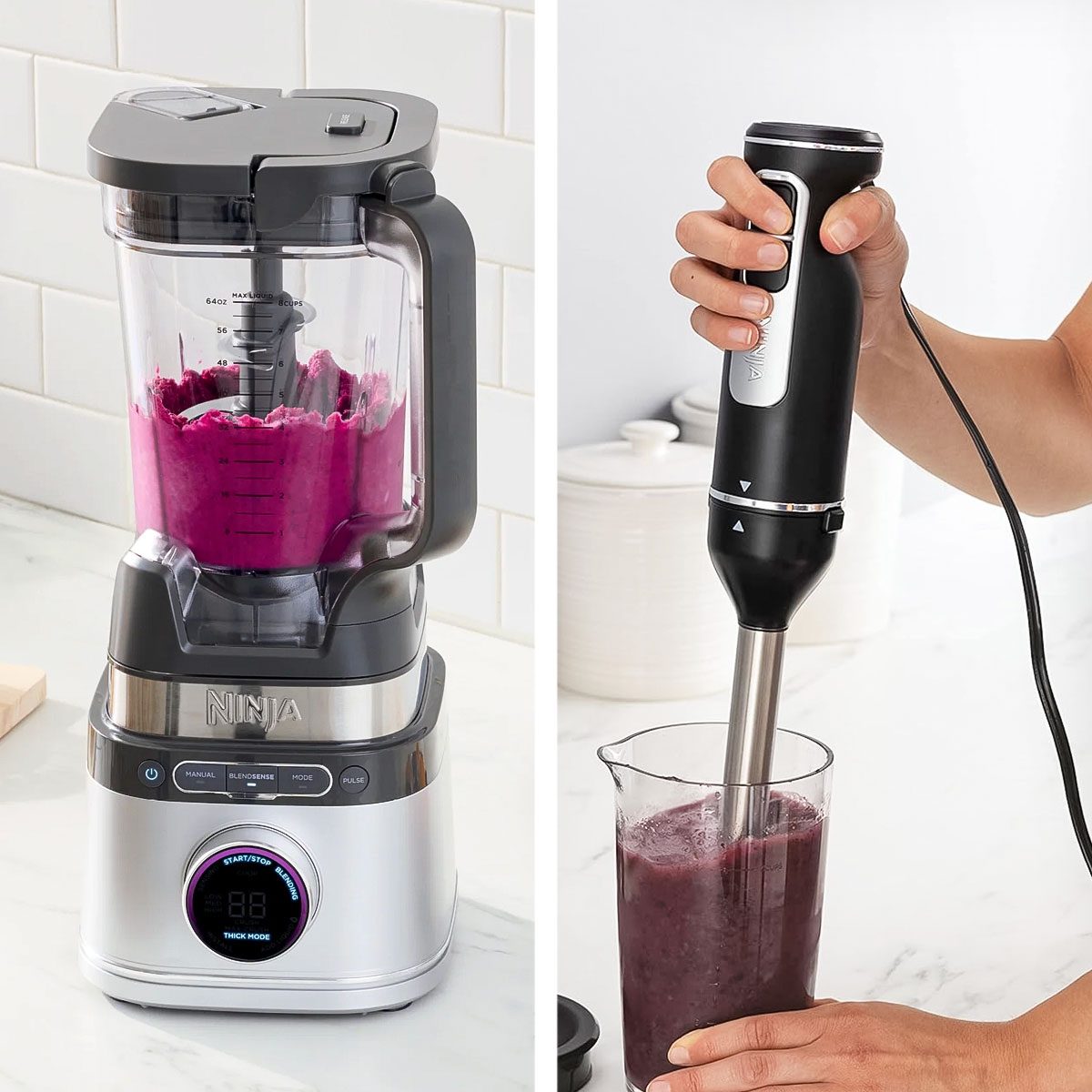Shopping for a new blender? Don’t rush to buy a traditional blender right away. First, compare a countertop blender with an immersion blender to see if a smaller model will suit your needs.
Read on for the difference between types of blenders and our recommendations for the best blenders.
 sydney watson/taste of home
sydney watson/taste of home
What is a countertop blender?
When you think of a blender, your mind probably goes to a countertop model. That is, a lidded pitcher mounted on a motorized base that makes the blades spin inside the pitcher.
These larger blenders—like those made by Vitamix—often have many settings, including puree, blend, chop and even crush ice for frozen drinks. Features like these make countertop blenders the go-to tool for making homemade smoothies, purees and smooth soups.
Contrary to popular belief, cleaning a blender is easy, so don’t hesitate to plug yours in whenever it’s needed.
Pros
- Powerful
- Versatile, thanks to multiple speeds and features
- Splash-free blending
- Super smooth results
Cons
- Takes up valuable kitchen space
- Pricey
 EMIKO FRANZEN FOR TASTE OF HOME
EMIKO FRANZEN FOR TASTE OF HOME
EMIKO FRANZEN FOR TASTE OF HOME
EMIKO FRANZEN FOR TASTE OF HOME
Pros:
-
Smart BlendSense setting
-
Three-tiered removable blade
-
Included single-serving pitchers
-
Safety features
-
7-year warranty
-
Great value
-
Easy to clean
Cons:
-
Large
-
Not as suitable for small yields
What is an immersion blender?
Buying an immersion blender—also known as a stick or hand blender—is another option. These gadgets are smaller than their countertop counterparts. They consist of a motorized handle with an easy-to-clean, detachable blending mechanism. Some models include extra attachments like whisks or even small food processors.
Immersion blenders are suited to a wider variety of tasks than traditional blenders. Because they’re compact, they’re ideal for making small-batch recipes like vinaigrettes and other homemade salad dressings.
Stick blenders also work well to smooth out sauces and soups. With this gadget, there’s no need to transfer the recipe to a pitcher or bowl; you can blend it right in your Dutch oven. In general, handheld blenders work best with softer ingredients, so don’t try to crush ice with one of these!
Pros
- Affordable
- Compact and easy to store
- Easy to clean
- Ideal for small jobs
- Can blend right in your cooking vessel—no need to transfer to a pitcher
Cons
- Can’t chop, crush, etc.
- Not as powerful as countertop models
 EMIKO FRANZEN FOR TASTE OF HOME
EMIKO FRANZEN FOR TASTE OF HOME
EMIKO FRANZEN FOR TASTE OF HOME
EMIKO FRANZEN FOR TASTE OF HOME
Pros:
-
Hand-mixer attachment and multiple accessories
-
Dishwasher-safe
-
Top performer in all tests
-
Various speed settings
-
Maneuverable
Cons:
-
A little messy
-
Some arm fatigue
Which type of blender is best?
To choose between an immersion blender and a traditional blender, consider your needs. If you make lots of smoothies, baby food, frozen drinks or big batches of soup, we recommend a powerful countertop model.
If you don’t reach for a blender very often, pick up a less expensive immersion blender. You can still blend ingredients in soups and sauces, but you won’t need to sacrifice a ton of storage space.
This being said, the right solution for you might be to have one of each type. Both are incredibly useful gadgets that can be awfully fun to use!
Put Your Blender to Good Use
Berry Smoothie Bowl
We turned one of our
favorite smoothies into a smoothie bowl and topped it with even more fresh fruit and a few toasted almonds for a little crunch. —
Taste of Home Test Kitchen, Milwaukee, Wisconsin
Go to Recipe
Chipotle Butternut Squash SoupMy hearty soup uses herbs and vegetables from the garden along with convenient pantry items, so it’s easy, fast and mostly fresh. Your family will devour it. —Roxanne Chan, Albany, California
Pork Tacos with Mango SalsaI've made quite a few tacos in my day, but you can't beat the tender filling made in a slow cooker. These are by far the best pork tacos we've had—and we've tried plenty. Make the mango salsa from scratch if you have time! Yum. —Amber Massey, Argyle, Texas
S'mores Milk ShakeWhen cabin fever hits, we whip up a beverage that tastes like s’mores. Oven-toasted marshmallows and a blender make it happen. —Sarah McKenna, Centennial, Colorado
Homemade Hot SauceMake your own hot sauce at home with this spicy recipe. Habanero and serrano peppers provide bold heat that's balanced by the sweetness of carrots and onions. We'll also show you how to can hot sauce for long-lasting flavor.
Peach-Chipotle Baby Back RibsMy son and I collaborated in the kitchen one day to put our own unique twist on classic baby back ribs. We added a sweet peachy glaze and a little heat with chipotle peppers. It was a great bonding experience, and now we have a keeper recipe for fall-off-the-bone ribs. —Rebecca Suaso, Weaverville, North Carolina
Eggplant SandwichThis eggplant sandwich with tomato and goat cheese is grilled to perfection and layered on a crusty ciabatta roll for a delicious meatless meal.
Spiced Pumpkin Coffee ShakesThe winter holidays are my favorite time of year, and this spiced pumpkin drink is one reason I love the season so much. If you don't have a coffee maker, it's OK to use instant coffee—just make it stronger. —Kathie Perez, East Peoria, Illinois
Cod with Hearty Tomato SauceCod in tomato sauce is a sweet, flavorful recipe that goes excellently with nutty grains and starches such as brown rice or whole wheat pasta.
Berry Breakfast ParfaitsExpecting brunch company but short on time? Parfaits are the perfect solution. Feel free to mix and match with whatever berries you have on hand. —Lisa Speer, Palm Beach, Florida
Pronto Potato PancakesPancake lovers know these fluffy delights are not just for breakfast. Try serving these savory ones as a side dish with any main, or enjoy them solo topped with some homemade applesauce. They will not disappoint. —Darlene Brenden, Salem, Oregon
HorchataIn this Horchata recipe, the mixture of ground rice and almonds is accented with a hint of lime. Depending on your preference, you can use more or less water for a thinner or creamier beverage. —
James Schend,
Dairy Freed
Makeover Traditional CheesecakeThough softer than a full-fat cheesecake, this lightened-up dessert has all of the original's delectable flavor. It's sure to make any special event more festive. —Anne Addesso, Sheboygan, Wisconsin
Fennel Carrot SoupThis soup is perfect as a first course for a special-occasion dinner. It gets its delicious flavor from toasted fennel seeds—a pleasant complement to the carrots, apple and sweet potato. —Marlene Bursey, Waverly, Nova Scotia
Butternut Squash and Sausage Stuffed ShellsI rarely invite friends for dinner without someone requesting this easy pasta casserole. The sweet squash complements the spicy sausage, and the creamy goat cheese makes it all just melt in your mouth! You can substitute manicotti or even rolled lasagna noodles for the shells. The stuffed shells and sauce can be prepared a day ahead and assembled just before baking. —Taylor Hale, Sonoma, California
Ginger Salmon with Cucumber Lime SauceLime with ginger is a favorite flavor combo for me, especially with grilled salmon. So good. Even with the cucumber sauce, this recipe is easy, too. —Noelle Myers, Grand Forks, North Dakota
Yogurt Breakfast DrinkSleepyheads will savor this dreamy smoothie. Simply blend yogurt, milk and orange juice concentrate for a fresh start to your day. —Renee Gastineau, Seattle, Washington
German PancakesWhip up a show-stopping centerpiece for your breakfast spread with our recipe for German pancakes.
Creamy Seafood EnchiladasShrimp and crab cooked with a flavorful sauce add up to outstanding enchiladas. I made them for an annual fundraiser, and now they’re always in demand. Spice up the recipe to your taste by adding more green chiles and salsa. —Evelyn Gebhardt, Kasilof, Alaska
Strawberry Watermelon SlushWe like to relax on the back porch with glasses of my slush after a long, hot day. Strawberries and watermelon blend up with lemon juice and sugar for an instant refresher. —Patty Howse, Great Falls, Montana
Bananas Foster Baked French ToastMmm…bananas Foster for breakfast! This yummy baked French toast serves up all the taste of the spectacular dessert in fine fashion. —Laurence Nasson, Hingham, Massachusetts
Mom's Meat LoafMom made the best meat loaf, and now I do too. When I first met my husband, he wasn't a meat loaf guy, but this recipe won him over. —Michelle Beran, Claflin, Kansas
Taco ChiliRanch dressing mix is the secret ingredient that makes this Mexican taco chili recipe so amazing that guests will wonder how you made it. To make things even better, the chili practically cooks itself in a slow cooker once you've browned the beef.
Strawberry MilkshakeGrab your spoon: this strawberry milkshake is thick, bright with strawberry flavor and infinitely customizable.
Black Bean TartThis colorful dish was a hit at a get-together I had for friends. I served the tart with sour cream on the side, a green salad and crusty bread. —Ellen Papa, Miami, Florida.
Pork, Bean & Rice BurritosGet ready for tailgate season with these slow-cooker pork burritos, featuring tender spice-rubbed pork wrapped up with rice, beans, and your choice of toppings. They're an easy and satisfying meal well-suited for any casual occasion.
Roasted Tomato SoupTurn fresh tomatoes, garlic and onion into a roasted tomato soup that explodes with flavor.
Strawberry-Carrot SmoothiesMy children resist veggies, but they love this carrot smoothie. It packs in lots of good-for-you fruits and veggies—but to my kids, it's just a super delicious breakfast. —Elisabeth Larsen, Pleasant Grove, Utah



 EMIKO FRANZEN FOR TASTE OF HOME
EMIKO FRANZEN FOR TASTE OF HOME
 EMIKO FRANZEN FOR TASTE OF HOME
EMIKO FRANZEN FOR TASTE OF HOME